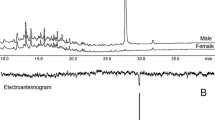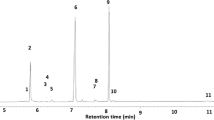Abstract
The male-produced sex pheromone of the neotropical redbanded stink bug, Piezodorus guildinii (W.) (Hemiptera: Pentatomidae), a serious pest of soybean in Central and South America, was identified as the sesquiterpene hydrocarbon β-sesquiphellandrene by coupled gas chromatography–mass spectrometry and laboratory bioassays. The identity was confirmed by comparison with an authentic standard, and its absolute configuration was determined to be (7R)-(+)-β-sesquiphellandrene. The mean rate of release was approximately 40 ng d−1 male−1. The compound was found only in extracts from sexually mature males. Laboratory olfactometer bioassays showed that 200 ng of the synthetic compound applied to a filter paper strip was as attractive to female bugs as odors from five 15-d-old live males, an airborne extract from males, or the fraction of the extract that contained (7R)-(+)-β-sesquiphellandrene.






Similar content being viewed by others
References
Aldrich, J. R., Numata, H., Borges, M., Bin, F., Waite, G. K., and Lusby, W. R. 1993. Artifacts and pheromone blends from Nezara spp. and other stink bugs (Heteroptera: Pentatomidae). Z. Naturforsch. 48C:73–79.
Borges, M. and Aldrich, J. R. 1992. Instar-specific defensive secretions of stink bugs (Heteroptera: Pentatomidae). Experientia 48:893–896.
Borges, M. and Bldrich, J. R. 1994. Attractant pheromone for nearctic stink bug, Euschistus obscurus (Heteroptera: Pentatomidae): insight into a neotropical relative. J. Chem. Ecol. 20:1095–1102.
Borges, M., Mori, K., Costa, M. L. M., and Sujii, E. R. 1998a. Behavioural evidence of methyl-2,6,10-trimethyltridecanoate as a sex pheromone of Euschistus heros (Heteroptera: Pentatomidae). J. Appl. Entomol. 122:335–338.
Borges, M., Schmidt, F. G. V., Sujii, E. R., Medeiros, M. A., Mori, K., Zarbin, P. H. G., and Ferreira, T. B. 1998b. Field responses of stink bugs to the natural and synthetic pheromone of the neotropical brown stink bug, Euschistus heros (Heteroptera: Pentatomidae). Physiol. Entomol. 23:202–207.
Borges, M., Zarbin, P. H. G, Ferreira, J. T. B., and Costa, M. L. M. 1999. Pheromone sharing: blends based on the same compounds for Euschistus heros (F.) and Piezodorus guildinii (W.) (Heteroptera: Pentatomidae). J. Chem. Ecol. 25:629–634.
Borges, M., Birkett, M., Aldrich, J., A., Oliver, J. E., Chiba, M., Murata, Y., Laumann, R. A., Barrigossi, J. A., Pickett, J. A., and Moraes, M. C. B. 2006. Sex attractant pheromone from the rice stalk stink bug, Tibraca limbativentris Stal. J. Chem. Ecol. 32:2749–2761.
Chavan, S. P., Dhondge, V. D., and Patil, S. S. 1997. Enantiospecific total synthesis of (+)-laevigatin. Tetrahedron: Asymmetry 8:2517–2518.
Corrêa-Ferreira, B. S. and Moscardi, F. 1996. Biological control of soybean stink bugs by inoculative releases of Trissolcus basalis. Entomol. Exp. Appl. 79:1–7.
Costa, M. L. M., Borges, M., and Vilela, E. F. 2000. Effect of stereoisomers of the main component of the sex pheromone of Euschistus heros (F.) (Heteroptera: Pentatomidae) in the attractiveness of female. An. Soc. Entomol. Bras. 29:413–422.
Endo, N., Wada, T., Nishiba, Y., and Sasaki, R. 2007. Interspecific pheromone cross-attraction among soybean bugs (Heteroptera): does Piezodorus hybneri (Pentatomidae) utilize the pheromone of Riptortus clavatus (Alydidae) as a kairomone? J. Chem. Ecol. 32(7):1605–1612.
Jackman, L. M. 1960. Hydrogenation–dehydrogenation reactions, pp. 329–364, in R. Raphael, E. C. Taylor, and H. Wynberg (eds.). Advances in Organic Chemistry. Methods and Results, vol. II. Interscience Publishers, New York.
Joulain, D. and Konig, W. A. 1998. The Atlas of Spectral Data of Sesquiterpene Hydrocarbons. E.B.-Verlag, Hamburg.
Leal, S. W., Kuwahara, X. S., Higuchi, H., Marino, C. E. B., Ono, M., and Meinwald, J. 1998. Male-released sex pheromone of the stink bug Piezodorus hybneri. J. Chem. Ecol. 24:1817–1829.
Mcbrien, H. L., Millar, J. G., Rice, R. E., Mcelfresh, J. S., Cullen, E., and Zalom, F. G. 2002. Sex attractant pheromone of the red-shouldered stink bug Thyanta pallidovirens: a pheromone blend with multiple redundant components. J. Chem. Ecol. 28:1797–1818.
Millar, J. G. 1998. Rapid and simple isolation of zingiberene from essential oils. J. Nat. Prod. 61:1025–1026.
Moraes, M. C. B., Laumann, R. A., Cokl, A., and Borges, M. 2005a. Vibratory signals of four Neotropical stink bug species. Physiol. Entomol. 30:175–188.
Moraes, M. C. B., Millar, J. G., Laumann, A. R., Sujii, E. R., Pires, C. S. S., and Borges, M. 2005b. Sex attractant pheromone from the neotropical red-shouldered stink bug, Thyanta perditor (F.). J. Chem. Ecol. 31:1415–1427.
Panizzi, A. R. and Rossi, C. E. 1991. The role of Acanthospermum hispidum in the phenology of Euschistus heros and Nezara viridula. Entomol. Exp. Appl. 59:67–74.
Shepard, M., Lawn, R. J., and Schneider, M. A. 1983. Insects on Grain Legumes in Northern Australia. A Survey of Potential Pests and Their Enemies. Univ. Queensland Press, St. Lucia, Australia.
Singh, O. P., Singh, K. J., and Thakur, R. D. 1989. Studies on the bionomics and chemical control of stink bug, Piezodorus rubrofasciatus Fabricius, a new pest of soybean in Madhya Pradesh. Ind. J. Plant Prot. 17:81–93.
Zarbin, H. G. P., Borges, M., Santos A. A., Oliveira, A. R. M., Simonelli, F., and Marques, F. A. 2000. Alarm pheromone system of stink bug Piezodorus guildinii (Heteroptera: Pentatomidae). J. Braz. Chem. Soc. 11:424–428.
Zhang, A., Borges, M., Aldrich, J. R., and Camp, M. J. 2003. Stimulatory bug volatiles for the neotropical brown stink bug, Euschistus heros (F.) (Heteroptera: Pentatomidae). Neotrop. Entomol. 32:713–717.
Acknowledgements
We thank Hélio Santos, Diva Tiburcio, and Camila Raquel for helping with field collection and laboratory rearing of the insects used in this study. This work received financial support from the Brazilian Council for Scientific and Technological Development (CNPq), Distrito Federal Research Foundation (FAPDF), and EMBRAPA. This research was also supported by the International Foundation for Science, Stockholm, Sweden, through a grant to Maria Carolina Blassioli Moraes.
Author information
Authors and Affiliations
Corresponding author
Rights and permissions
About this article
Cite this article
Borges, M., Millar, J.G., Laumann, R.A. et al. A Male-produced Sex Pheromone from the Neotropical Redbanded Stink Bug, Piezodorus guildinii (W.). J Chem Ecol 33, 1235–1248 (2007). https://doi.org/10.1007/s10886-007-9294-1
Received:
Revised:
Accepted:
Published:
Issue Date:
DOI: https://doi.org/10.1007/s10886-007-9294-1




